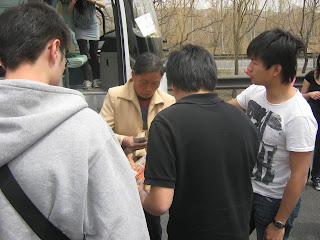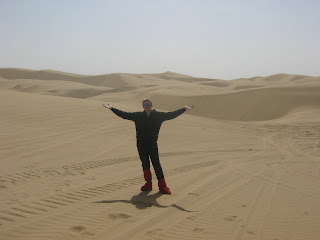Tianjin is quite close, so it can be done in a day trip from Beijing. We took the train in the morning, and arrived in Tianjin in time for lunch. On the train, I found out that the train goes further out than Tianjin, which would have been good to know - the carrier is much closer to the last station on the line, Tanggu.

Tianjin again!
We had some lunch near the train station, and walked around for a bit, before moving on towards the carrier. We took a taxi to the light rail station, and then took the train out to Tanggu. From there, it was another long taxi ride to where the carrier is, near Binhai. It seems to be in a huge military-themed recreational area, with old fighter jets and armoured vehicles lining the streets, and paintball and laser fields.

China must have had a lot of MiG-19s to get rid of.
Eventually we made it to the carrier. It's not cheap to get in, but it wasn't too busy, and was pretty impressive walking in.

The park has a few static displays on the land, but most of the interesting stuff is inside the ship. The lower decks have been refitted as a museum, full of exhibits about naval history, technology, and the Chinese military, as well as the actual weapon systems of the ship, which have been left in place.

Torpedo Shooting Cabin
Some of the control areas and crew amenities have been kept as well, and are full of mostly-original equipment and creepy Russian mannequins.



While this is one of the best tourist attractions I've been to in China, it keeps plenty of the sort of oddities you can't avoid here. For example, one of the control rooms has a screen playing a loop of a tense scene from the Chinese dub of the Hunt for Red October. There are also a couple of things that have nothing to do with the aircraft carrier, like the Tube of Swirly Lights, but not too many. One particularly interesting (depending on your point of view, frightening) area is all about the situation of the Chinese military, from its development, its role in disaster relief, and the space program, to a display entitled "Fierce challenges" filled with pictures and models of American equipment, a world map showing deployments of US forces, and some maps of Taiwan showing where ROC forces are stationed, and the range of their cruise missiles.
Moving on, we made it to the flight deck, which was pretty cool. There was an Mi-8 helicopter, a number of Nanchang Q-5 attack planes (another type China seems to have made way too many of), and a Yak-38 (Russian answer to the Harrier), apparently brought in specially for a show where a man was to pull it along the deck with his head, judging by the posters.

Yak-38

Mi-8, or Harbin Z-6, the world's most-produced helicopter.

Looking along the flight deck. The Q-5s at the other end were never designed for carriers and would almost certainly not be able to use this runway.
The island, the tower on the side of the flight deck, is also mostly open and accessible. You can go up and pretend to be the captain.


The flight deck only takes up the rear 2/3 of the ship. The front is all weapons. Russian carriers were designed as cruisers as well, so they carry anti-air, anti-ship, and anti-submarine weapons.

On our way down to check this out first-hand, we found the officers' quarters. It's not really clear if they are still being used - they could be used as a hotel, like the cabins on the ship in Dalian.




We still hadn't seen everything there was to see inside the ship. We went through the ammunition storage for the cannons, and the crew quarters, complete with mannequins.



Finally, we went through the hangar, which is now home to an odd collection of mocked-up aircraft, a SuperCobra, an F-117 stealth fighter, and a Chengdu J-10, China's own modern fighter. The J-10 was well-done, the American planes looked a bit strange and had misspelled labelling.

We then left the ship, and went to look at the displays on the beach. It was, by the looks of it, a really odd life-size diorama of scenes from major wars of the 20th century.




There were also a couple more interesting displays of modern equipment - a Russian Ka-50 attack helicopter, and an Su-27 which looks like it was sent here after a particularly hard landing.


Having exhausted all the displays (the free ones, at least) we went home. We took a taxi to Tanggu and got the train from there. They sold us seatless tickets, so we had to stand for the 45 minutes from Tanggu to Beijing, then stand another 45 minutes on the crowded Beijing subway before getting back to the campus.

The train is fast, which is pretty cool.
It was also the birthday of our neighbour Lukas, and the party was just getting started when I got back at about 8:30. It was another barbeque on the balcony, with all the Chileans and Spaniards, so it was fun.





















